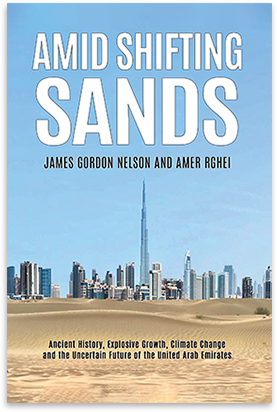
Review by James Gardner
Amid Shifting Sands by James Gordon Nelson and Amer Rghei is a unique and timely addition to the literature on the United Arab Emirates. It is unique because we are reminded throughout that, beneath the stunning modernity greeting the visitor to the UAE, there are deep cultural and natural roots that extend well into the prehistory of the region. Such reminders are timely in the context of the explosive late-20th century and continuing growth of wealth, infrastructure, and population set against the future challenges of changing climate and weather, limited resources and degrading natural and cultural heritage. Nelson and Rghei pull together threads from the existing literature and knowledge about the region with their own field observations and narratives over several years. They provide a perspective from which we can inform our own understanding and exploration, and consider at some depth, the future of the UAE and the rich cultural and natural heritage therein.
The book consists of an Introduction followed by thirteen chapters taking the form of stand-alone essays supported by useful maps and illustrations. A set of sixteen photographs is found at the end of the book. The first four chapters set the stage by describing European exploration, early peopling from the Paleolithic onwards, transformation from nomadic life to an urban nation, and implications of explosive growth for recognition and conservation of cultural and natural heritage. The following two chapters focus on Dubai, firstly in an examination of gardens, parks and protected areas and secondly, in describing the evolution from traditional souks to the modern shopping and multipurpose malls. In these two chapters, the authors successfully integrate background material with their own field observations gained by walkabouts and local travel, a process that is repeated effectively in following chapters.
The remaining seven chapters focus on specific sites, locations and regions of the UAE. A visit to the Grand Mosque of Sheikh Zayed in Abu Dhabi includes discussion of the multiple roles of a mosque in Islamic life and description of the design and the details and origins of the materials of the mosque. Al Ain, the ancient and currently important urban oasis complex adjacent to the border with Oman, is covered in the following two chapters through considerations of its origins and history, followed by a detailed description of the authors’ visit and exploration of the area. The edge of the great sand desert, Rub al Khali or “Empty Quarter”, at the Liwa oases, is the focus of Chapter 10. We follow the authors from Abu Dhabi across the extensive sabkha salt plain to the dune fields marking the northern edge of the Rub al Khali. Various settlements in the Liwa oases complex are described and a fascinating discussion of the modern life of Bedouin descendants with residence in both rural Liwa and urban Abu Dhabi is included. Among the authors’ goals in the Liwa visit was to reach the large and developing natural protected area of Umm az-Zamul in the far southeast of the Abu Dhabi Emirate and the Liwa crescent. Though unsuccessful in reaching their goal, the authors provide a useful discussion of conservation and protection in the future of the UAE, a theme found throughout the book. The final three chapters take the reader to the northeast of the UAE with visits to Ras al Khaimah and surroundings, Fujairah, and the Musandam Peninsula which is shared with Oman. Together, these chapters provide a helpful addition to the literature on an area that until recently has been off the beaten track of most visitors to the UAE. As in the preceding chapters, these call upon existing literature and knowledge together with the authors’ field observations. Apart from the urban industrial landscapes focused in Ras al Khaimah and Fujairah, the Musandam Peninsula is dominated by the Hajar Mountains with topographic and ecological diversity not found elsewhere in the UAE. This and the fact that the area has been less affected by the oil boom, leads to a concluding discussion of the need for greater understanding of past and present conditions as a basis for conservation and management of natural cultural heritage.
Amid Shifting Sands conveys a good sense of the remarkable social and economic change of the past half-century in the region we now call the United Arab Emirates. It does so against a well-written backdrop of a rich prehistory and history. As such, it will provide a good vantage from which to observe what could be a challenging future for the UAE and surrounding regions.
Post Views : 57